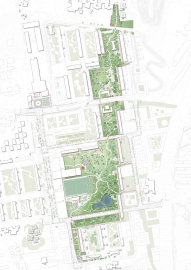Gellerup New Nature Park
Gellerup New Nature Park shows how to create a new nature-based model for transforming the typologies of 1960’s social housing estates from socially challenged ‘living machines’ into socially and environmentally sustainable humane neighborhoods.
Gellerup is Denmark’s largest social housing project and its most notorious example of 1960’s social planning that transformed most of Europe’s cities and suburbs. Built to provide its citizens with modern amenities, however most of these housing estates deteriorated into ghettos with social and cultural challenges and segregation as a result.
The answer to these social problems has all too often been demolition of homes and forced evictions of socially weak inhabitants. This anti-social approach does not solve the deeper problems of our social housing estates and their lack of social cohesion and meaning.
SLA’s project Gellerup New Nature Park creates a new nature-based model for transforming these typologies of 1960’s social housing estates: From socially challenged ‘living machines’ into socially and environmentally sustainable nature-based humane neighborhoods
Our interdisciplinary team of anthropologists, biologists, architects and urban planners used a nature-based design approach to create the park. The strategy was to use nature to increase the residents’ life quality, improve community feeling, catalyze social cohesion and to increase the area’s biodiversity. The ambition was to create a new understanding of the importance of living together – with nature and with each other.
The park was designed in three parts: 1) An extensive citizens engagement process determined the overall programs of the city nature: Ballparks, football fields, nature playgrounds, picnic areas, community gardens etc; 2) The park’s new architectural elements (paths, lighting, pavilions) created cohesion and safety; 3) The new nature was designed in collaboration with citizens to make sure it strengthens the desired social change.
The result is a new form of ‘social nature’ that has measurably improved the safety, the biodiversity and the life quality of the area. Through our own anthropological and biological surveys we continuously monitor the social and biotic growth and development of Gellerup into a flowering, social neighborhood.
SLA solved the social challenges by designing one large coherent park: The former wildernesses that created insecurity were removed and replaced by more varied nature that ensures overview of the park thus increasing security. New paths across the city park were added to improve the accessibility of the park. The paths curve around trees and nature, making it impossible to use the paths for highspeed mopeds (which created insecurity in the past). More than 2000 new trees have been added. The trees are all specially selected based on their functional, social and aesthetic capabilities. They are planted to create a good microclimate in the park, effectively handle cloud bursts and provide a strong aesthetic feeling of nature. The trees have a large species variation, a conscious homage to Gellerup's large ethnic diversity, creating a strong sense of ownership of the park for the residents. The varied species make the park robust to climate change and allow for a maximum of animals, bees and insects to find habitat in the park: from rare bee species to rabbits, squirrels and foxes. Thus, the park provides home to humans, animals and plants alike - in a new form of urban symbiosis.









